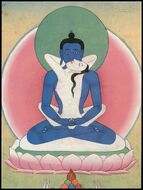Ādibuddha
(Redirected from Adi-Buddha)
Jump to navigation
Jump to search
ādibuddha (T. dang po'i sangs rgyas དང་པོའི་སངས་རྒྱས།; C. benchu fo 本初佛), or "primordial buddha," is the personification of the enlightened state within Buddhist tantra. In Tibetan Buddhism, the primordial buddha (ādi-buddha) is often represented by Buddha Samantabhadra (within the Nyingma school), or Buddha Vajradhara (in the Sarma schools).[1] In East Asian Buddhism, the primoridal buddha is typically considered to be Vairocana.[1]
The 14th Dalai Lama states:
- I understand the Primordial Buddha, also known as Buddha Samantabhadra, to be the ultimate reality, the realm of the Dharmakaya-- the space of emptiness--where all phenomena, pure and impure, are dissolved. This is the explanation taught by the Sutras and Tantras.[2]
Karl Brunnhölzl states:
- Longchenpa's Treasure Trove of Scriptures...explains that Samantabhadra — one of the most common Dzogchen names for the state of original buddhahood — is nothing other than the primordial, innate awareness that is naturally free, even before any notions of "buddhas" or "sentient beings" have emerged.[3]
Metaphor for our true condition
According to Chogyal Namkhai Norbu, the primoridal buddha "should be mainly understood as a metaphor to enable us to discover our real condition." He states:
- If we deem Samantabhadra an individual being, we are far from the true meaning. In reality, he denotes our potentiality that, even though at the present moment we are in samsara, has never been conditioned by dualism. From the beginning, the state of the individual has been pure and always remains pure: this is what Samantabhadra represents. But when we fall into conditioning, it is as if we are no longer Samantabhadra because we are ignorant of our true nature. So what is called the primordial Buddha, or Adibuddha, is only a metaphor for our true condition.[4]
Not to be interpreted as a god-figure
Chogyal Namkhai Norbu responds to the following question:
- Question: What does it mean, then, that Samantabhadra is the "first" enlightened one and that he has never transmigrated?
- Answer: We cannot talk about the true condition of the primordial state in terms of "before" and "after," as if there was somebody before and then something else arose. These are all limited concepts, and it is necessary to go beyond time. Samantabhadra means our state, and should not be interpreted as God in the sense of a supreme entity who is the only creator, for example.[4]
Notes
- ↑ 1.0 1.1 Buswell & Lopez 2014, s.v. ādibuddha.
- ↑ "Dalai Lama Answers Questions on Various Topics". hhdl.dharmakara.net.
- ↑ Brunnhölzl 2018, p. 17.
- ↑ 4.0 4.1 Chogyal Namkhai Norbu & Clemente 1999, Epilogue: On the Nature of Samantabhadra.
Sources
- Brunnhölzl, Karl (2018), A Lullaby to Awaken the Heart: The Aspiration Prayer of Samantabhadra and Its Commentaries, Simon and Schuster
 Buswell, Robert E.; Lopez, Donald S. (2014), The Princeton Dictionary of Buddhism, Princeton University
Buswell, Robert E.; Lopez, Donald S. (2014), The Princeton Dictionary of Buddhism, Princeton University- Chogyal Namkhai Norbu; Clemente, Adriano (1999), The Supreme Source: The Kunjed Gyalpo, The Fundamental Tantra of Dzogchen Semde, Snow Lion Publications
External links
 dang_po'i_sangs_rgyas, Rangjung Yeshe Wiki
dang_po'i_sangs_rgyas, Rangjung Yeshe Wiki Adi-Buddha, Rangjung Yeshe Wiki
Adi-Buddha, Rangjung Yeshe Wiki དང་པོའི་སངས་རྒྱས་, Christian-Steinert Dictionary
དང་པོའི་སངས་རྒྱས་, Christian-Steinert Dictionary Adi-Buddha, Wikipedia
Adi-Buddha, Wikipedia

